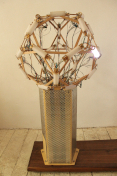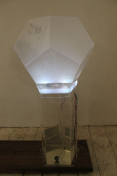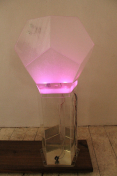style="position:absolute; width:704px; z-index:1;
left:235px; visibility:visible ; top: 230px;
| |
|
|||
| |
|
|||
|
|
|
|
||
|
Systems on different
scales are nested and interconnected to form a larger whole.
Causal realtaionships among the parts result in a dynamic
for the larger whole. A degree of chance exists within the
confines of established boundry conditions. Two
dodechahedrons are mounted on a wooden base. One of these
twelve-sided geometrical forms is constructed of wood, has
electronic components and paper tubes forming all its edges.
Three circuit boards, each with a Light Emitting Diode (LED)
and Light Dependent Resistor (LDR) are mounted at every
corner in such a way that when an LED at one end of an edge
emmits light, the light shines through the paper tube along
the edge and the LDR at the other end receives the signal.
The groups of three circuit boards at the corners are each
connected to a small microprocessor. When an LDR at the end
of an edge receives the signal, a program on the
microprocessor causes the LED on one of the other two
circuit boards at the activated corner to illuminate, with a
50% chance for each. The illuminated LED then sends a signal
along its edge to an LDR sensor at one of the neighboring
corners and the process is repeated. In this way a signal in
the form of light is passed among the nodes at the corners
of the dodechahedron, continually meandering in a random
fashion within the confines of the geometric form. The other
dodechahedron is constructed of transparent colorless
plexiglass. An ultrasonic mist maker is emersed in an about
5cm deep pool of water at the bottom of the form and a small
computer fan is mounted near the top. The mist maker is
always on, resulting in a gently ungulating layer of mist at
the bottom of the dodechahedron. The plexiglas dodechahedron
is mounted on a five sided plexiglas stand which is filled
with water. At the top of this stand, directly under the
dodechahedron, a five-sided layer about 3 cm thick has
traslucent whie plexiglas walls and houses five LEDs. These
LEDs below the dodechahedron illuminate the mist from below
with a white light. The geometry of the dodechahedron is
such that the corners exist on six horizontal levels. The
level of the active node in the first dodechahedron is
communicated to a microprocessor. When the nodes in the
upper-most level are activated, the LEDs illuminating the
mist on the second dodechahedron turn red and the fan at the
top turns on thereby disturbing the layer of mist. In this
way, the sensor network with the LDRs and LEDs is set up in
such a way that each agent only receives input from its next
neighbors. Yet their influence has a greater range as these
parts construct a larger system which in turn interacts with
its environment. Through the interaction of individual
subsystems, a larger system emerges. /div>
|


